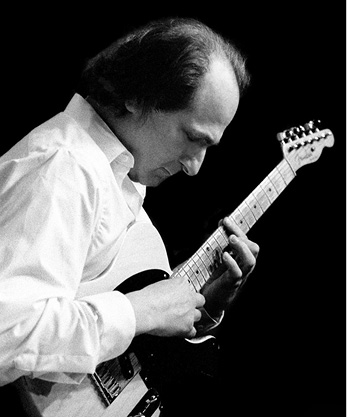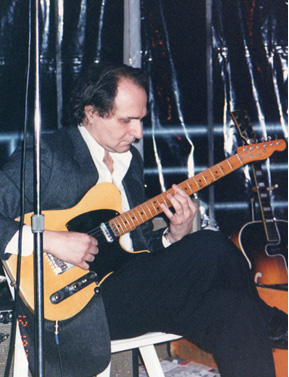20
The Greatest Unknown Guitarist
My master plan had always been to sell a few guitars to provide myself a little financial freedom. I hoped eventually I would have time to actually study guitar.
If you lived in LA and you were into guitar, there was only one person to study with—Ted Greene. I have known and done business with some of the greatest guitarists in the world, and I can say without question that Ted was miles above them all.

Ted Greene with Blackguard Fender 1953 Telecaster. (Photo by Bob Barry)
Through it all, he never raised his price per lesson. It was always $15 or $20, from the seventies all the way until his untimely death in 2005. Everybody studied with him, from Andy Summers to Lee Ritenour.
Ted’s knowledge of chord voicings and inversions on guitar was encyclopedic and revolutionary. He had studied with George Van Eps, but we all felt he’d surpassed the master. Ted was the ultimate “chord melody” guitarist, but he damn near knew every song ever written and loved all kinds of music.
He had written a famous book in the seventies called Chord Chemistry, illustrating his hundreds of chord voicings. There was so much material in that book, nobody in the world could digest it! That, along with his cover photo with a thick beard and a modified cherry red ES-355, solidified his reputation as an eccentric genius, which was probably an understatement.
Ted later used to refer to his book as “Chord Catastrophe.” He knew that he should have found a way to simplify all this information, but as it is, the book remains a mystifying document.
•••
I met Ted through my vintage guitar business, back when I was selling out of my apartment. Ted would customize all these old guitars I’d sell him, but I couldn’t really get down on him for that, because he was so brilliant and was always in search of some kind of mystery guitar sound. Later, he started to respect some of the guitars he bought a little more. He bought some Blackguard Teles from me, a Gibson Switchmaster, and toward the end, became very interested in finding and playing Guild guitars, because he felt they were a really good value for the money.
Ted was a legend out here, yet he only recorded one solo album in his lifetime. I knew him when he played with a group called the Bluesberry Jam, back in about 1970. He also used to teach at Ernie Ball’s store on Ventura Boulevard, not far from where my store is now.
Ted was an iconoclast, and we all loved him for it. He was so methodical about everything. He had the smallest handwriting of anybody I’ve ever seen. He documented every musical discovery he ever made, which was considerable. He would spend most of his time sitting cross-legged on the floor, formulating his ideas, and writing them down. Thank God he did that, because his musical insights are available, though in a lifetime only Ted himself could master them.
Though he’s known for his chord work, he was also a phenomenal single-note player. He was into doo-wop, which is where he and I found common ground. He loved the Moonglows, just like I did. He even liked the way I sang. Somewhere in my archives I have a tape of his accompanying me, but I always felt my vocals and others’ were a chain around his leg. I’d rather just hear him play on his own.
He was a fascinating, creative musician, who never repeated himself—he was always improvising, coming up with mind-boggling arrangements on the fly. But he was so modest that he’d never even announce a gig. You’d have to find out from somebody else that he was playing somewhere around town. He also had a frustrating habit of backing up singers who were not on his level. I think he just wanted to take the focus off himself, which was near impossible once he had a guitar in his hands.
I remember one Tuesday night he was playing at the Baked Potato in North Hollywood. The first set was classic Ted, solo guitar at its finest. He played every part in the Percy Faith Muzak hit “Theme from a Summer Place.” He covered all the string parts, and everything else, and knocked everyone out.
For the second set, he came out playing the old spiritual “Swing Low, Sweet Chariot.” Well, there’s nothing hip or even accessible on that tune. It was just bizarre. What made it more bizarre is that he proceeded to invite all these “singers” up on the bandstand, and each singer tried to “cut” each other by oversinging, and overemoting. It was just awful. Then he pointed to me, and I shook him off. No way was I going up there.
In some ways, he reminded me of Dylan, because you just did not know whether he was screwing with people or was being sincere about these things. I know he sincerely saw the good in everybody, but it was odd.
Once, I heard he was going to be playing at a restaurant called the Sea Shell, right up the street from my store. I went there, and there were about twenty people in the restaurant.
Ted was sitting at a table with his dad, and I’ll never forget this, he had a baked potato on a plate in front of him. You could hear his guitar, but you couldn’t see it. He was hiding his guitar under the table, playing while he was eating dinner. He’d hit a chord, let it ring, then take a bite of the potato! What a character. It was the nuttiest thing I’ve ever seen in my life.
Another time, Dan Duehren and I were at John Pisano’s guitar night, and Ted was the last guy to go on. He almost always gigged with a Telecaster, which was unusual for a jazz guy, but he got a beautiful tone on it. Still, he was a perfectionist, always on the hunt for the right sound.
Pisano would introduce everybody, and he was standing there waiting to introduce Ted, but Ted was messing around with his Deluxe Reverb amplifier on stage. He’d hit a chord, get up, go to the amp, turn some knobs, go back, sit, hit another chord, get up, go to the amp, et cetera. I mean this thing went on for fifteen minutes! Finally Danny said to John, “You’d better just introduce him, or we’ll be here ’til two in the morning!”
That was par for the course with Ted. He was an odd cat. He lived like a hermit in his apartment in Encino with stuff all around. I guess today you’d call him a hoarder. He was seriously into old cars, and he had car magazines and videotapes piled up to the ceiling. With all his interest in cars, the car that he drove was extremely modest. His apartment was organized, but it was also insane. You couldn’t even get into one of the bathrooms, it was so jammed full of stuff. It was organized, but it was also insane.
His diet was strange—he’d eat popcorn, french fries, and M&Ms. He didn’t really take care of himself, at all. He would sit in a yoga position all day, which couldn’t have been good for his circulation. He took care of everybody except himself. He was always the last on the list. I know that he was an insomniac and that might’ve accounted for his incredible musical productivity.
The man had heart. For our twenty-fifth wedding anniversary party, he backed up the great singer Donny Gerard on Marlene’s favorite James Ingram song, “One Hundred Ways.” It was so beautiful, a memory permanently etched into my mind.
For all his influence, there’s precious little recorded output. We begged him to record more, but he professed never to be ready. This man was more ready than any other guitar player on the planet! His perfectionism kept him from getting all his brilliance down on tape. He could’ve made a lot more money in music, but he just liked teaching and showing people things on the guitar. Ted would teach anybody, and he would always find something positive in a person’s playing, no matter how crude it might be.
When I “studied” with him, I was really into Curtis Mayfield, and Ted liked my R&B rhythm playing. But I was always too busy to practice, so it never led anywhere. I didn’t feel it was right for me to take up some other deserving student’s time.
About a month before he died, he traded me a bunch of his old guitars for some Guilds. One was an early 1960s Gibson ES-345 that I held onto for many years. Ted had stuffed foam into the ƒ-holes and that had reacted against the pickups. It dissolved the P.A.F. stickers. I kept that guitar in the store, with a picture of Ted playing it stuck onto the strings, until one of his students really wanted it. I figured that Ted would rather have the guitar played than just sitting there.
There is not a person who plays guitar in LA who has not been touched by Ted, directly or indirectly. It seems almost every week I meet someone who had an experience with him or is studying Ted’s lessons on the Ted Greene website.
They say that genius is closely related to insanity. I guess Ted was living proof of that. The gift is that he didn’t have to die to be discovered. All of us knew and honored his genius while he was still alive.
I am struck by the fact that his talent and art still looms large as the years go by. I was lucky that I got to be around when a genius like Ted was doing his thing. I won’t see another one like him in this lifetime.

Ted Greene playing at Norman and Marlene’s twenty-fifth wedding anniversary. (Photo by Marlene Harris)